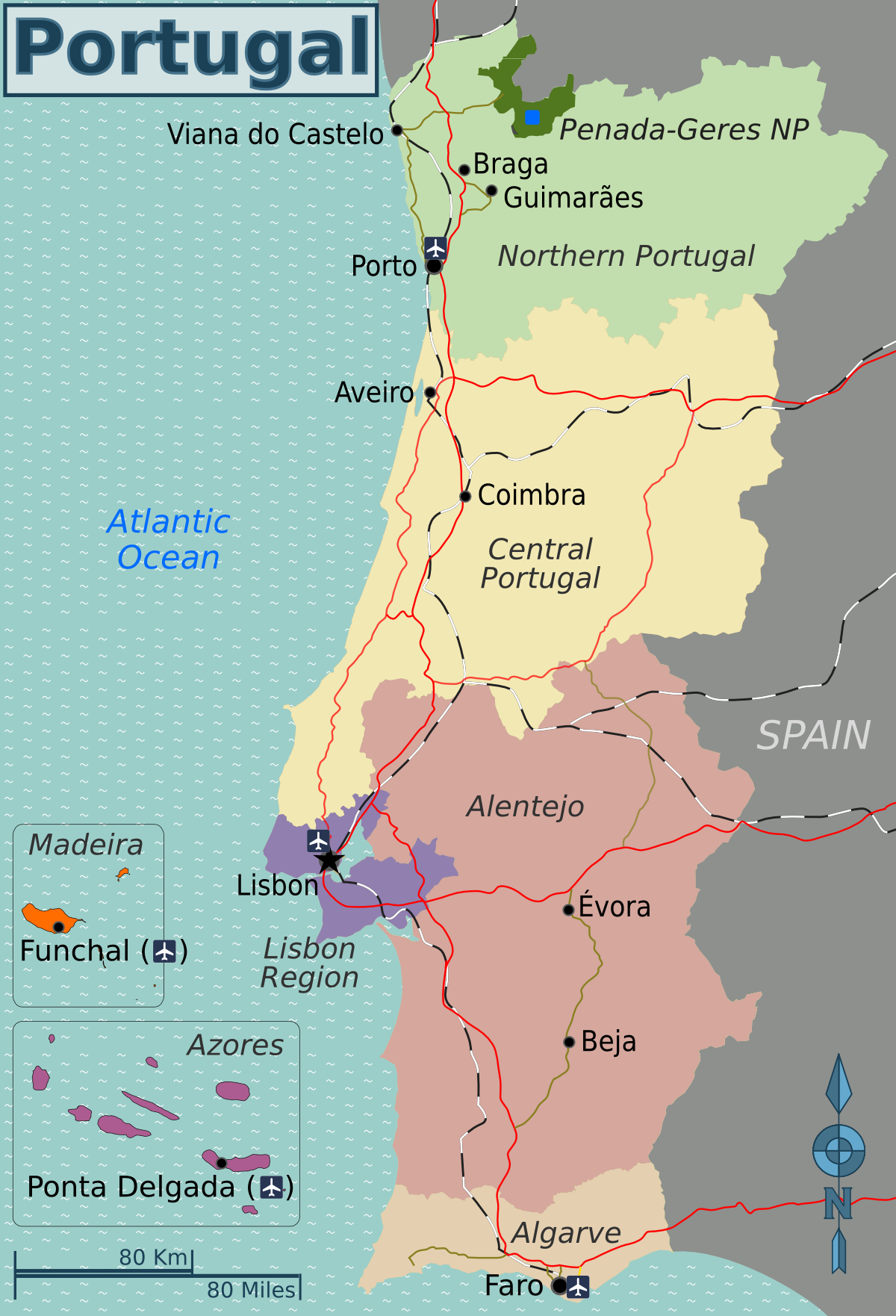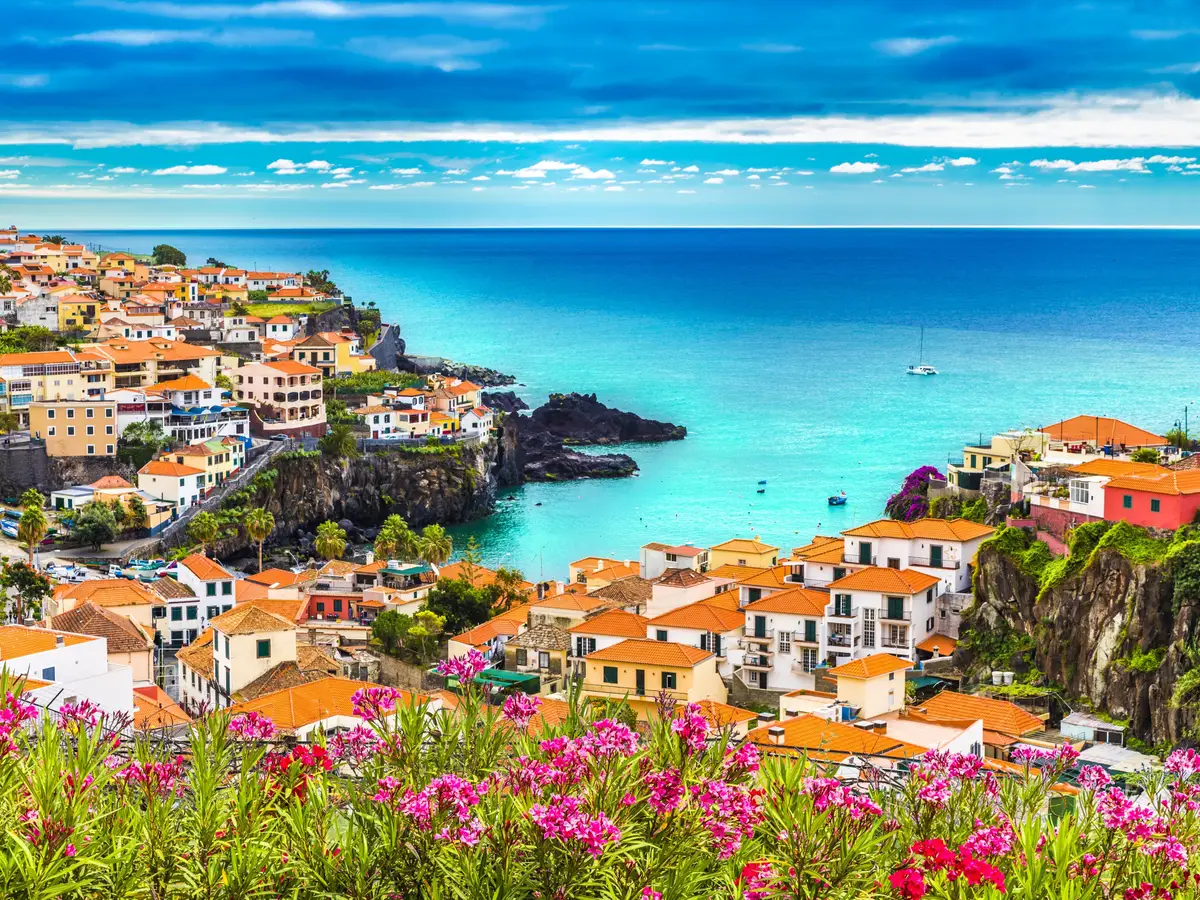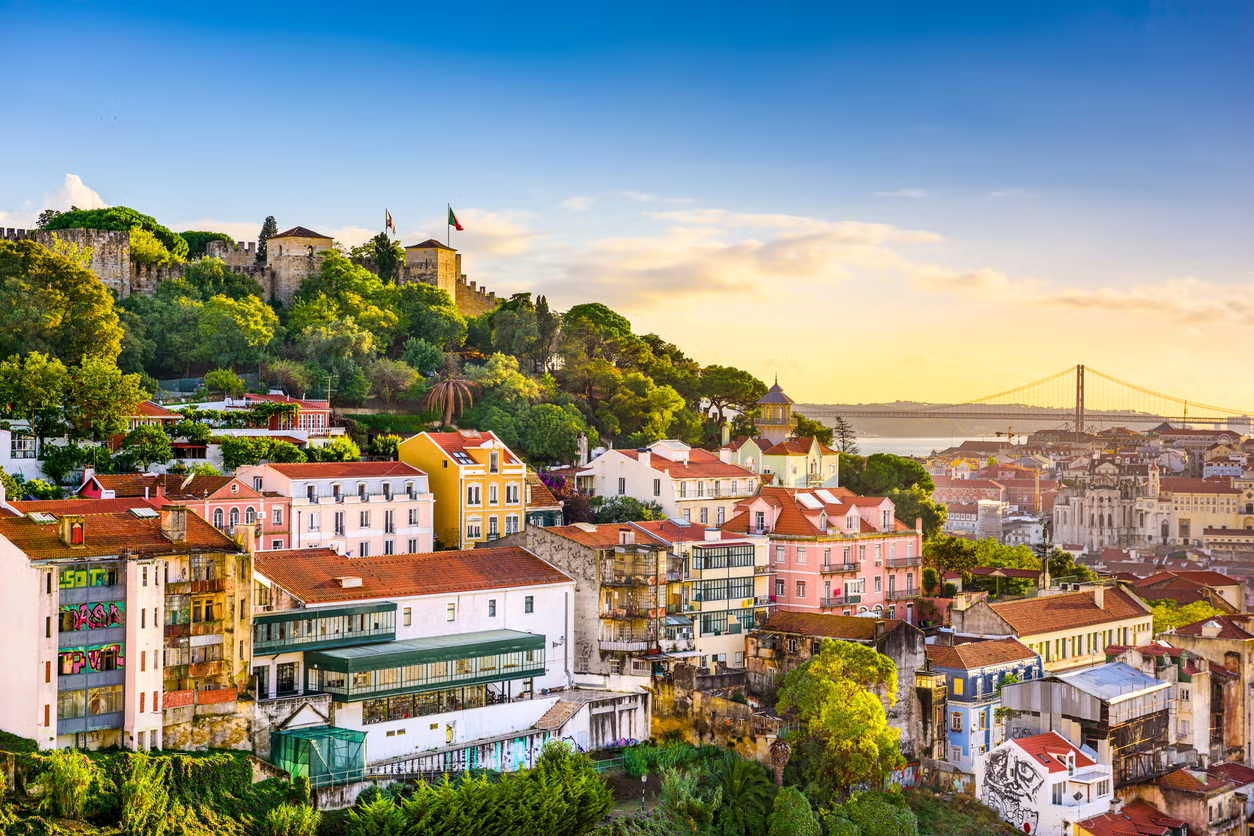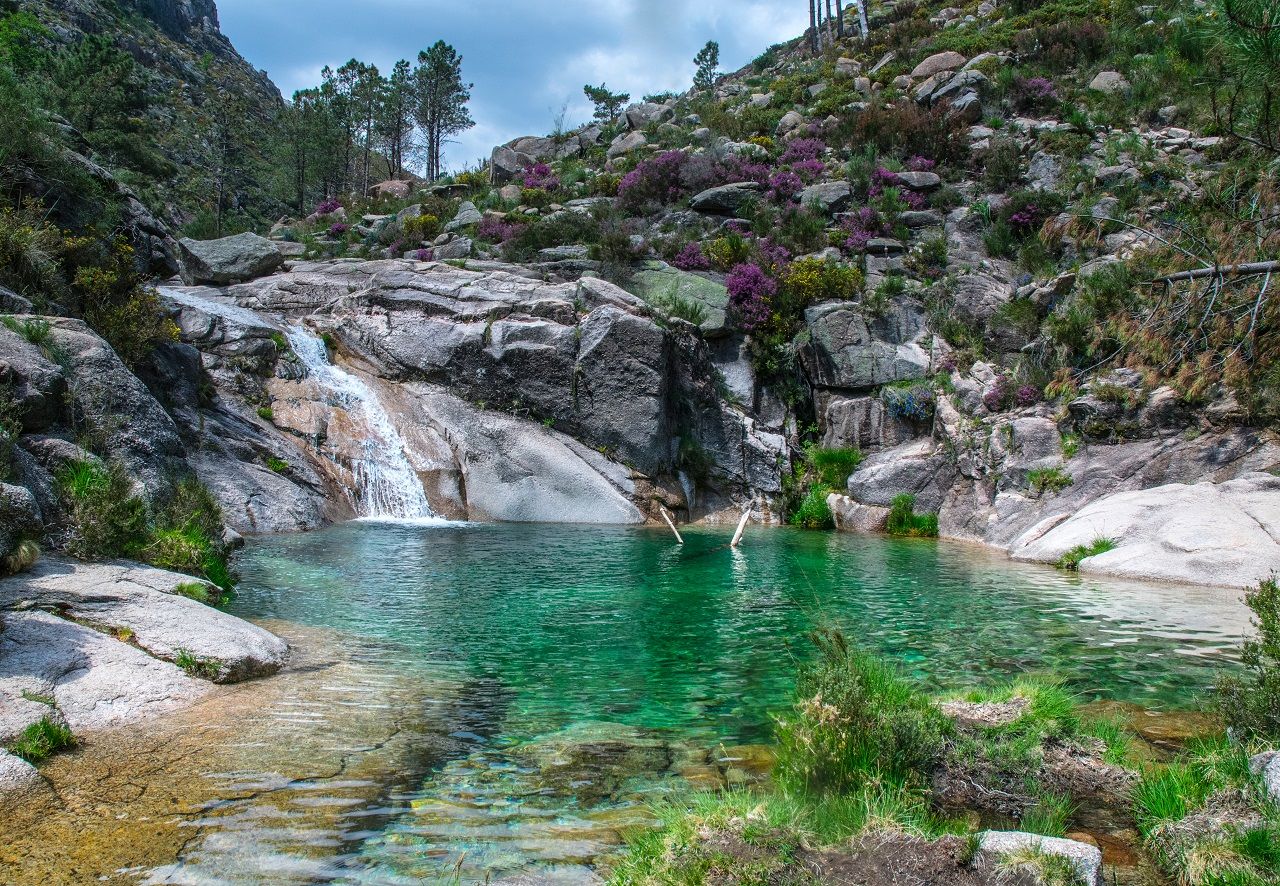Map Of Portugal - Top Routes And Key Landmarks
Navigating Portugal can be difficult without the proper resources. A map of Portugal is created to provide you with the precise information necessary to simplify your journey. It’s not solely about traveling from one location to another; it’s about discovering the charm in every nook of the country.
Author:Finn WildeReviewer:Michael RachalFeb 17, 202595.9K Shares1.2M Views
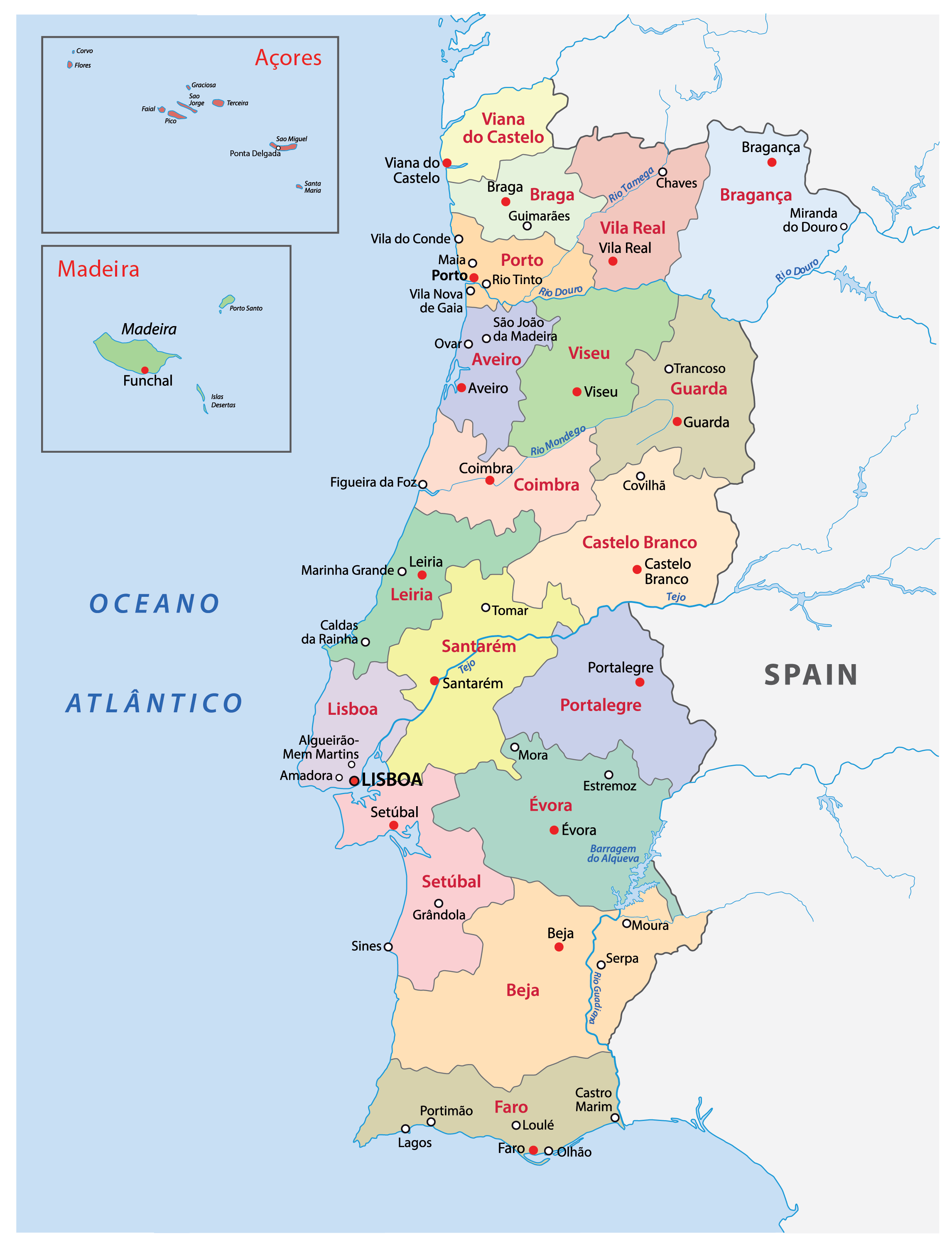
Portugal, a nation with a vibrant history and varied landscapes, presents much more than it initially appears. The allure of Portugal lies in its strong traditions, stunning architecture, and famous gastronomy.Celebrated for its Mediterranean weather, rich cultural legacy, and intriguing historical sites, Portugal has drawn in travelers for generations.
Its beautiful beaches, imposing cliffs, and tranquil islands encourage visitors to discover and relax, while the kindness and warmth of the Portuguese people enhance the overall experience.
Geographical Overview Of Portugal’s Map
Portugal covers one-sixth of the Iberian Peninsula, situated at the southwestern corner of Europe. To the north and east lies Spain, which encompasses the remainder of the peninsula.
The Atlantic Ocean borders Portugal to the south and west, while the Azores and Madeira Islands are found to the west and southwest. Although small, Portugal boasts a variety of geographical features, ranging from coastal plains to the Estrela Mountains, which rise to nearly 6,500 feet (2,000 meters).
The northern part of Portugal, along with Spanish Galicia, creates a mountainous border with the Meseta, the ancient rocky foundation of the Iberian Peninsula. The southern region of Portugal primarily consists of limestone and other sedimentary rocks, characterized by plateaus and plains.
Portugal shares significant rivers with Spain, including the Douro, Tagus (Rio Tejo), and Guadiana, all of which start in the central Meseta and flow westward (or southward in the case of the Guadiana) toward the Atlantic.
The closeness of the Meseta affects the climate, resulting in greater rainfall in northern Portugal, which fosters lush plant life. Conversely, southern Portugal enjoys a Mediterranean climate and vegetation.
Map Of Portugal’s Cities
Lisbon
Lisbon presents a distinctive blend of culture, history, and way of life. Visit the Belém district, where various monuments commemorate Portugal's navigators. Stroll through the Alfama neighborhood to witness local life, and check out the lively districts of Baixa, Chiado, and Bairro Alto, each with its unique charm.
Porto
Porto boasts a rich historical heritage and was the origin of the country's name, "Portugal." From shopping on Rua Santa Catarina to admiring the Capela das Almasadorned with 15,000 azulejos, Porto exudes a European allure. For a more immersive experience, consider wine tours and river cruises available in Porto.
Faro
Faro, a lesser-known treasure in Portugal, harmoniously combines historic allure with contemporary conveniences. Its old town is characterized by narrow streets filled with cafés, shops, and ancient structures. Don't miss the 13th-century cathedral and the Roman triumphal arches, as well as the best wineries in the Algarve region.
Evora
Evora, a UNESCO World Heritage site, is rich in Roman relics, medieval architecture, and stunning churches. Walk around the historic center, visit the Cathedral of Evora, and explore the Chapel of Bones. The area is also renowned for its traditional Alentejo cuisine and local wines.
Aveiro
Aveiro, previously famous for salt production and maritime commerce, now features a bustling harbor and lively attractions. Enjoy leisurely tours aboard Moliceiro boats, which were once used for seaweed harvesting, now highlighting the city’s maritime heritage.
Sintra
Sintra is a fairy-tale location filled with breathtaking palaces, castles, and grand mansions set amidst forests and hills. The Palácio da Pena, an iconic example of Romantic architecture, is a must-visit site and one of the most popular destinationsin Portugal.
Coimbra
Coimbra harmonizes historical significance with contemporary culture. Its old town is home to ancient edifices which host prestigious universities, forming a cultural epicenter. It's blessed with numerous museums, galleries, theaters, extensive history, and lively nightlife.
Madeira
Madeira presents an ideal combination of nature, culture, and heritage. Its spectacular landscapes encourage outdoor adventures, while colonial towns, historic churches, and museums reflect its past. Participate in local festivals and experience the cuisine and wine tours offered in Funchal.
Ponta Delgada
Ponta Delgada, located on the Azores Islands, features cobblestone streets, colonial-style buildings, and a blend of natural beauty with historical sites. It acts as the entrance to the volcanic craters, verdant landscapes, and unspoiled beachesof the Azores. Enjoy the region’s distinctive wineries and unique offerings.
Population Of Portugal
Portugal's population is around 10.3 million individuals, primarily made up of ethnic Portuguese, along with smaller groups of Brazilians, Han Chinese, and people from former Portuguese colonies in Africa and Asia.
The nation also has a community of ethnic Marranos, who are the descendants of Jews that converted to Christianity while secretly maintaining their Jewish traditions. The Roma (Gypsy) community mainly resides in the Algarve region. Nearly the entire population speaks Portuguese as their first language, which acts as a common unifying element throughout the country.
The demographic profile of Portugal indicates an aging populace, with a notable percentage of individuals aged 65 and older. The country is experiencing low birth rates, contributing to a slow decline in its population.
Regions On The Map Of Portugal
Relief
Less than one-eighth of Portugal's territory lies at elevations exceeding 2,300 feet (700 meters). Most of the country's mountain ranges are situated north of the Tagus River, which flows from northeast to southwest, effectively dividing the country. In the northern area, over 90% of the land rises above 1,300 feet (400 meters). In contrast, in the south, only the São Mamede range reaches elevations above 3,200 feet (1,000 meters).
North
In the northwestern region, the mountainous landscapes of the Minho province, marked by the Larouco Mountains that reach heights of 5,010 feet (1,527 meters), form an amphitheater facing the Atlantic Ocean. This area consists of metamorphic rocks (such as crystalline schists, slates, and quartzites) and intrusive or granitic formations, with fault lines that create natural hot springs.
The granitic regions feature rolling plateaus and streams that have deeply carved the terrain, while areas with schist exposures generally possess less fertile soil. Rivers like the Lima and Cávado flow through deep gorges or flat valleys. The narrow coastal strip is flanked by hills that sharply ascend to altitudes of 1,000 to 2,000 feet (300 to 600 meters).
Northern Interior
On the other side of the Minho mountains lies Trás-os-Montes, flanked by Spain on two sides. The area located south of the Douro, which stretches from the Spanish Meseta, encompasses Beira Alta and Beira Baixa.
In the northern section of the interior, elevated plateaus (terra fria, or “cold country”) ranging from 2,000 to 2,600 feet (600 to 800 meters) are deeply fractured and primarily made up of ancient Precambrian rock (over 540 million years old), including granites, schists, and slates. This forms a rolling landscape.
Rivers flow along structural lines and move in a northwest-southeast direction. Following rejuvenation over the last 5 million years, they now navigate through profound valleys and canyons that plunge as deep as 1,600 feet (500 meters) below sea level. The Nogueira Mountains, a distinctive monadnock, peak at 4,330 feet (1,320 meters).
A similar geological pattern and relief are observed south of the Douro, where the protected valleys of dark schists retain the warmth of a Mediterranean climate, resulting in a terra quente (or “hot country”). The elevated Beiras plain is bordered to the northwest by the Caramulo Mountains (3,527 feet [1,075 meters]) and the Montemuro Mountains (4,531 feet [1,381 meters]) along with their foothills.
To the south and southeast, the granite and schist escarpment of the Estrela Mountains, together with the lesser Guardunha Mountains (4,026 feet [1,227 meters]), extend the Central Sierras of Spain into Portugal. Situated between these two ridges, the Guarda plateau averages an elevation of 3,000 feet (900 meters).
The mountain range continues southwest towards the Açor Mountains (4,652 feet [1,418 meters]) and the Lousã Mountains (3,953 feet [1,205 meters]). Further south, the weathered plateau of Beira Baixa descends from 1,600 feet (500 meters) to 700 feet (200 meters) toward the Tagus River, merging with the elevated areas of the Alto Alentejo.
South
Approximately sixty percent of Portugal's territory located below 1,300 feet (400 meters) is situated in the southern region. The plains, primarily composed of Triassic sandstones, stretch from the lower Douro to Lisbon and the lower Tagus, gently sloping towards the low-lying and occasionally marshy coastal areas of the former western provinces of Beira Litoral and Estremadura.
Although efforts since the 19th century have stabilized shifting sands and dunes, lagoons and salt marshes still exist at the river mouths, including the Aveiro Lagoon at the mouth of the Vouga River.
Further inland, to the east and south of Leiria, Jurassic limestones combined with Cretaceous sandstones and conglomerates have formed rolling hills and steep cliffs rich in calcium. The remnants of ancient volcanic activity can be seen in the form of basalt plateaus.
Between the Tagus and Guadiana rivers, the Alto Alentejo, which extends into the Spanish plateaus, contains crystalline plateaus (Paleozoic Cambrian and Silurian schists) ranging from 600 to 1,300 feet (180 to 400 meters), characterized by poor soils, save for areas where diorite outcrops have weathered into fertile black soils, or limestone, which have spring-fed areas at their foot.
To the north of Beja, in Baixo Alentejo, northwest-southeast oriented ridges of quartz and marble form a uniform, undulating landscape between 300 and 600 feet (90 and 180 meters). This region culminates in the schistous Caldeirão Mountains, which rise to 1,893 feet (577 meters).
Shielded from northern climatic effects by the mountains, the Algarve showcases more extensive hills and scarps composed of Mesozoic limestones and sandstones. The Monchique Mountains, an eroded massif made of intrusive igneous rock (syenite), soar to a height of 2,959 feet (902 meters) at Mount Foia.
The Madeira Islands
The Madeira archipelago is made up of eight volcanic islands located in the Atlantic Ocean, approximately 600 miles (1,000 km) southwest of mainland Portugal. Only the islands of Madeira and Porto Santo have inhabitants. Madeira presents an asymmetrical mountainous shape in the ocean, reaching an elevation of 6,109 feet (1,862 meters) in its interior while dropping steeply on its northern side.
Thick layers of basalt, mixed with ash and scoriae, form a stepped terrain that is deeply carved into gorges and canyons. The Curral das Freiras crater descends to a depth of 2,265 feet (690 meters). Paul da Serra is a desolate high-altitude plateau. The eastern edge of Madeira, similar to the uninhabited Desertas Islands, features sandy areas. Porto Santo is characterized by its low and flat terrain.
The Azores
The Azores are made up of nine islands scattered over 400 miles (650 km) in the mid-Atlantic region. The island of Santa Maria, located farthest to the east, is situated 875 miles (1,408 km) away from the mainland of Portugal, whereas Flores, the westernmost island, is approximately 1,230 miles (1,980 km) from Cape Race in Newfoundland, Canada.
These islands are of volcanic origin and are occasionally active. Their diverse landscapes feature crater lakes, plateaus at various heights, mountainous ranges, flat-bottomed valleys, and rugged shorelines. The Ponta do Pico volcano on Pico Island reaches a height of 7,713 feet (2,351 meters), making it the tallest point in metropolitan Portugal.
Lisbon - The Capital Of Portugal
Lisbon serves as the capital of Portugal and is a significant port, forming the heart of the Lisbon metropolitan area. Located in the western part of Portugal at the estuary of the Tagus (Tejo) River, it is the westernmost capital in continental Europe and functions as the nation's main port, largest city, and center for commerce, politics, and tourism.
The city’s name has its origins in the ancient title Olisipo (Ulyssipo), with its establishment associated with various myths, including those of Ulysses from Homer’s Odyssey and Elisha, a descendent of the Hebrew patriarch Abraham, as well as more plausibly, Phoenician settlers. The historical importance of Lisbon is primarily attributed to its natural harbor, regarded as one of the most picturesque in the world.
The city covers an area of 33 square miles (85 square km) and recorded a population of 547,733 in 2011 and 544,851 in 2021, while the metropolitan area had 2,821,876 residents in 2011 and 2,871,133 in 2021. Lisbon is constructed on a series of terraces that elevate from the banks of the Tagus River and the Mar de Palha to the northwest, leading toward the Sintra Mountains.
The region is adorned with Mediterranean and Atlantic European flora, providing a delightful refuge for its inhabitants. The elevation of the city varies, particularly in the older areas close to the waterfront, which offer breathtaking views of the river and the low cliffs along the southern bank.
Several geological faults traverse Lisbon and its vicinity; however, following the devastating earthquake of 1755, seismic activity has been minimal, with only sporadic tremors recorded in the 20th century.
Types Of Maps Of Portugal
Physical Maps Of Portugal
Physical maps of Portugal illustrate the country's geographical features, including mountains, rivers, plains, and coastal areas. These maps highlight key landmarks such as the Serra da Estrela mountain range, the Douro River, the Algarve coast, and the Azores and Madeira archipelagos. They offer a clear depiction of the landscape and its physical attributes, emphasizing elevations, valleys, and natural parks.
Political Maps Of Portugal
Political maps represent the administrative framework of Portugal, dividing the nation into regions, districts, municipalities, and parishes. These maps outline Portugal's borders with its neighboring countries, as well as the locations of significant cities like Lisbon, Porto, and Coimbra. Political maps also depict the distribution of various regions such as the Algarve, Alentejo, and the Azores, offering insights into the country's governance and political structure.
Tourist Maps Of Portugal
Tourist maps showcase popular sights, attractions, and cultural locations across Portugal. These maps pinpoint areas of interest, including the historic city of Sintra, the Tower of Belém, the Douro Valley, and the Algarve's beaches. They assist tourists in discovering regions renowned for wine tours, UNESCO World Heritage sites, national parks, and notable monuments, aiding visitors in exploring the nation’s rich cultural and natural heritage.
Road Maps Of Portugal
Road maps of Portugal deliver comprehensive details about the country’s transportation system, encompassing highways, main roads, and local routes. These maps indicate road conditions, toll systems, and connections between cities and regions. They are essential for planning car trips, facilitating efficient navigation through areas such as Lisbon, Porto, and rural locales, while also offering valuable overseas travel informationto ensure a smooth journey.
Topographic Maps Of Portugal
Topographic maps provide accurate information about the terrain, elevation, and landforms across Portugal. These maps are used for pursuits like hiking, trekking, and mountaineering.
They emphasize notable elevations such as the Serra da Estrela, which is the tallest mountain in mainland Portugal, along with the diverse topographies of both the mainland and the islands. These maps display contour lines and offer crucial data for outdoor enthusiasts to navigate through Portugal’s varied landscapes.
National Parks In Portugal
Parque Nacional Da Peneda-Gerês
Parque Nacional da Peneda-Gerês is the only national park in Portugal, situated in the northernmost part of the country. Covering around 700 square kilometers (270 square miles), it safeguards a variety of wildlife as well as the traditional ways of life of local residents. The park is home to approximately 100 small granite villages, where guests can witness ox-drawn carts and shepherds leading their herds to higher pastures in the warmer seasons.
In the park's woodlands, animals like wolves and ibex still roam freely. Aside from hiking along the ancient Via Geira Roman Road and kayaking on the Cávado River, visitors can discover megalithic structures and medieval castles, such as the 13th-century Castelo de Lindoso.
Parque Natural Da Serra Da Estrela
The Parque Natural da Serra da Estrela, the largest nature reserve in Portugal, is a destination for outdoor activities throughout the year. Spanning 890 square kilometers (344 square miles), the park features Portugal’s highest peaks, including Torre, which is the tallest point in the nation.
During spring, the hills are adorned with wildflowers, while autumn showcases the vibrant hues of birch, beech, and chestnut trees in the forests. In winter, the park provides consistent snowfall, making it an excellent spot for skiing, particularly for those new to the sport.
As summer arrives, the area becomes a hub for hiking, mountain biking, and various other activities, with trails available that range from simple paths to the more demanding 600-kilometer (373-mile) GR22. The nearby village of Manteigas provides accommodations and dining options conveniently located near 18 hiking trails.
Parque Natural Do Sudoeste Alentejano E Costa Vicentina
The southwestern shoreline of Portugal, located within the Parque Natural do Sudoeste Alentejano e Costa Vicentina, features stunning views with steep sea cliffs, rugged coves, and hidden beaches. For those who enjoy hiking, the Rota Vicentina presents a 227-kilometer (141-mile) trail that stretches along the coast from São Torpes to Sagres.
Besides hiking, the park is a favored spot for surfing, with surf camps available in Carrapateira, Odeceixe, and Aljezur. Guests can unwind on some of the Algarve’s least populated beaches and explore historical sites such as the Fortaleza de Sagres and the Cabo de São Vicente lighthouse, which marks the southernmost point of Europe.
Parque Natural Da Arrábida
The Arrábida Natural Park, situated less than an hour south of Lisbon, extends along the southeast coast of the Setúbal Peninsula. This protected area is abundant in Mediterranean vegetation, including lavender, olives, and thyme, and serves as a habitat for both kestrels and eagles.
The park's highest elevation, Serra do Risco, reaches 380 meters (1,246 feet) and provides stunning panoramic views of the coastline. Visitors can enjoy a refreshing swim at Praia dos Galapos, a tranquil beach famed for its crystal-clear waters, making Arrábida a perfect destination for families looking for both adventure and relaxation.
Parque Natural Da Ria Formosa
The Parque Natural da Ria Formosa is situated in the eastern Algarve and spans an area of 18,000 hectares (44,479 acres). This park is famous for its lagoons, marshlands, salt pans, and sandy barrier islands. One of the most tranquil islands, Ilha da Barreta, also known as Ilha Deserta, is uninhabited and provides a serene space for relaxation and birdwatching.
The mainland has trails like São Lourenço and Ludo where visitors can catch sight of bird species such as flamingos and glossy ibises. Exploring the park through boat or kayak trips offers the best chances to witness wildlife, including dolphins and the rare purple swamphen, which is a symbol of the park.
Major Routes And Highways In Portugal
The highway system in Portugal facilitates seamless connections between cities and regions. Below are several of the main routes and highways:
- A1 (Autoestrada do Norte): Connects Lisbon to Porto, passing through Coimbra and Leiria.
- A2 (Autoestrada do Sul): Links Lisbon to the Algarve, ending in Albufeira.
- A3 (Autoestrada do Minho): Runs from Porto to Valença near the Spanish border.
- A4 (Autoestrada Transmontana): Extends from Porto to Bragança in the northern interior.
- A6 (Autoestrada do Alentejo): Connects Lisbon with Elvas at the Spanish border, passing through Évora.
- A8 (Autoestrada do Oeste): Runs from Lisbon to Leiria, serving towns like Torres Vedras and Caldas da Rainha.
- A22 (Via do Infante): Stretches across the Algarve from Lagos to Vila Real de Santo António.
- A23 (Autoestrada da Beira Interior): Links Torres Novas to Guarda in central Portugal.
- A25 (Autoestrada das Beiras Litoral e Alta): Connects Aveiro to Vilar Formoso at the Spanish border.
- A28 (Autoestrada do Litoral Norte): Connects Porto with Viana do Castelo along the northern coast.
- IC1 (Itinerário Complementar 1): An alternative route from Lisbon to the Algarve, passing through Alcácer do Sal.
- EN2 (Estrada Nacional 2): Historic road stretching from Chaves in the north to Faro in the south.
- IP4 (Itinerário Principal 4): Provides access from Porto to Bragança in Trás-os-Montes.
- A10 (Circular Regional Externa de Lisboa): A bypass connecting Alverca do Ribatejo to Benavente near Lisbon.
- A14: Links Figueira da Foz with Coimbra in central Portugal.
Top Attractions On The Map Of Portugal
Dom Luís I Bridge
The Dom Luís I Bridge connects the city with Vila Nova de Gaia across the Douro River. This double-deck iron construction is an architectural wonder, providing stunning views of the river and its surroundings. Walking along the bridge is an essential experience for those visiting Porto.
Porto Cathedral
The Porto Cathedral features a combination of Romanesque and Gothic architectural elements. Inside, visitors can appreciate its impressive stained glass windows, detailed tomb carvings, and an interior that reflects its significant historical value.
Belém Tower
Belém Tower is a prominent emblem of Lisbon and one of its most famous landmarks. Erected in 1515 as part of the city's defense system, the tower stands beside the Tagus River and showcases the beauty of Manueline architecture.
Jerónimos Monastery
The Jerónimos Monastery is a stunning example of Portuguese Gothic architecture, built in the 16th century. Its intricate carvings and elaborate design make it one of the highlights of Lisbon’s cultural heritage. Visitors are welcome to explore the monastery’s cloisters, chapels, and the burial sites of notable historical figures.
São Jorge Castle
São Jorge Castle is a key part of Lisbon’s history and culture. Once a residence for royalty, the castle now stands as an important monument. Its walls provide stunning panoramic views of the city, making it a popular destination for tourists.
Quinta Da Regaleira
Quinta da Regaleira is recognized for its elaborate gardens, fountains, and underground passageways. Once a private estate, it now allows visitors to discover its intriguing features, including the mythical Initiation Well, a spiral staircase leading down into a deep cavern. The estate's gothic-style designs and enigmatic symbolism make it an enticing spot for those interested in history and culture.
Moorish Castle
The Moorish Castle was built in the 8th century as a strategic fortification. Its sturdy walls and towers have withstood the test of time and now serve as a historic site offering expansive views of the surrounding area, including glimpses of the Atlantic Ocean on clear days. Visitors can stroll along its ancient battlements and learn about its significance in Portugal’s medieval history.
Monserrate Palace
Monserrate Palace merges romantic architectural styles with elaborate gardens showcasing plants from all over the world. The palace's design reflects a fusion of Gothic, Moorish, and Indian influences, resulting in a distinct visual appeal. Visitors can roam the lush grounds, often frequented by peacocks, and admire the ornate interiors that previously hosted gatherings of the aristocracy.
Lagos
Lagos is renowned for its historical allure, scenic landscapes, and lively maritime culture. Its cobblestone streets are flanked by vibrant buildings, traditional shops, and cafes. Guests can partake in activities such as exploring nearby cliffs and caves or taking boat excursions to see dolphins and marine life in the crystal-clear waters.
Benagil Cave
Benagil Cave is a stunning limestone formation that can be reached by boat. The cave boasts a large circular opening in its ceiling, allowing sunlight to stream in and illuminate its interior, creating an extraordinary visual experience. Visitors can appreciate its unique structure and enjoy the tranquil beauty of the surrounding ocean.
Praia Da Marinha
Praia da Marinha, regarded as one of the Algarve’s most beautiful beaches, is famous for its golden sands and dramatic limestone cliffs. The beach is an ideal spot for swimming and snorkeling in its clear waters, rich in marine life. Its picturesque landscapes have made it a popular choice for postcards and travelphotography.
Funchal
Funchal blends a deep historical background with lively cultural practices. Its avenues boast ancient churches, colonial architecture, and a bustling market where local goods and crafts are sold. Tourists can savor traditional Madeiran cuisine and participate in festivals that honor the island's cultural legacy.
Monte Palace Tropical Garden
The Monte Palace Tropical Garden in Madeira features an array of exotic flora, vibrant blossoms, and decorative ponds. Guests can wander along its paths, which meander past stone sculptures, tiled mosaics, and flowing waterfalls. The garden also contains a museum that showcases artifacts and artwork from various cultures.
Pico Do Arieiro
Pico do Arieiro presents breathtaking views of the island's rugged landscape. The mountain is inhabited by distinct plant species and numerous bird varieties. Hiking routes traverse rocky terrains and connect to other summits, making it an appealing spot for nature enthusiasts and outdoor adventurers.
São Miguel Island
São Miguel Island boasts a variety of landscapes that range from lush valleys to volcanic craters. Visitors can discover its peaceful lakes, natural hot springs, and quaint villages. The island's fertile soil supports tea plantations and pineapple farms, enhancing its agricultural charm.
Lagoa Das Sete Cidades
Lagoa das Sete Cidades is encircled by steep hills and thick vegetation. The blue and green lakes, separated by a slender bridge, are rich in local legends and folklore. This area presents hiking paths and lookout points, offering guests breathtaking views of this natural marvel.
Currency Of Portugal
Portugal utilizes the euro as its official currency, with the abbreviation EUR and the symbol €. This currency was introduced in 1999 when Portugal joined the Eurozone, a collective of European Union nations that share the euro as their common currency.
The euro replaced the Portuguese escudo, which had been in circulation since the early 1900s. Euro coins and banknotes officially became the currency used in Portugal in 2002, making trade and travel easier among Eurozone countries. The European Central Bank issues and oversees the currency, promoting stability and consistency across member nations.
Ethnic Groups And Languages Of Portugal
While western Iberia has a long history of habitation, very few human remains from the Paleolithic Period (Old Stone Age) have been uncovered. Findings from the Neolithic Period (New Stone Age) and Bronze Age are more prevalent, including numerous dolmens (stone monuments).
Some of the earliest established communities were the northern castros, which are hilltop villages created by Neolithic farmers who cleared the woodlands. Migrating groups such as the Phoenicians, Greeks, and Celts mixed with the local populations, resulting in Celtic-influenced natives inhabiting the fortified castros.
For two centuries, these settlements served as strongholds against the Roman legions. Subsequently, the Romans, Suebi, Visigoths, Moors, and Jews left their mark on the area. Portugal's location at the western edge of Europe made it vulnerable to land invasions, and its vast coastline attracted maritime invaders.
Over ninety percent of the nation’s population is made up of ethnic Portuguese, alongside smaller communities of Brazilians, Han Chinese, and individuals from Portugal’s former colonies in Africa and Asia.
15 Interesting Facts About Portugal
- Portugal is one of the oldest countries in Europe. Its borders have remained unchanged since 1139, making it one of the longest-standing nations in the world.
- Lisbon is older than Rome. Portugal's capital is one of the oldest cities in Europe, predating Rome by several centuries.
- Portugal was a global maritime power. During the Age of Exploration in the 15th and 16th centuries, Portugal led the world in navigation and exploration, with notable figures like Vasco da Gama and Ferdinand Magellan.
- It has the world's oldest bookstore. Bertrand Bookstore in Lisbon has been open since 1732 and is recognized by the Guinness World Records as the oldest still-operating bookstore.
- Portuguese is the sixth most spoken language worldwide. Spoken by over 250 million people, it is the official language of nine countries, including Brazil, Mozambique, and Angola.
- Portugal produces over 50% of the world’s cork. The country is the largest producer of cork, and its cork oak forests are protected by law.
- The longest bridge in Europe is in Portugal. The Vasco da Gama Bridge in Lisbon stretches over 12.3 kilometers (7.6 miles).
- Portugal is home to the first demarcated wine region in the world. The Douro Valley, famous for its port wine, was established as a regulated wine region in 1756.
- The country has a rich tradition of Fado music. This soulful genre, recognized by UNESCO as Intangible Cultural Heritage, often reflects themes of longing and nostalgia.
- Portugal abolished slavery before many other nations. The country ended slavery in its territories during the early 19th century.
- It is a world leader in renewable energy. Over half of Portugal’s energy comes from renewable sources like wind, solar, and hydropower.
- Portugal introduced tea to Europe. Catherine of Braganza, a Portuguese princess who married England’s King Charles II, popularized tea drinking in England in the 17th century.
- The University of Coimbra is one of the oldest in Europe. Founded in 1290, it remains a prominent center of learning and is a UNESCO World Heritage Site.
- Portugal has a unique love for codfish. Known as "bacalhau," there are said to be over 365 ways to prepare it, one for each day of the year.
- It is one of the safest countries in the world. Portugal consistently ranks high on global safety and peacefulness indexes, attracting tourists and expatriates alike.
FAQs
What Is The Climate Like In Portugal?
Portugal features a Mediterranean climate, known for its hot, dry summers and mild, rainy winters. Cities along the coast, such as Lisbon and Porto, experience temperate weather year-round, whereas inland areas tend to show more significant seasonal changes.
Are There Any UNESCO World Heritage Sites In Portugal?
The country is home to numerous UNESCO World Heritage Sites, including the Monastery of Batalha, the Cultural Landscape of Sintra, and the Historic Centre of Porto. These sites illustrate Portugal's rich historical background and architectural variety.
What Are Portugal's Most Famous Traditional Dishes?
Portugal is famous for its culinary heritage, which includes dishes like bacalhau (salted cod), pastel de nata (custard tart), and caldo verde (a soup made with kale and chorizo). These meals highlight the nation’s vibrant flavors and locally sourced ingredients.
What Is Portugal’s Most Celebrated Festival?
The Festa de São João in Porto is one of the most significant festivals in Portugal. This festive occasion features fireworks, music, and a peculiar custom where participants gently hit each other with plastic hammers as part of the fun.
Conclusion
Portugal is a location that merges history, culture, and breathtaking scenery into an unforgettable experience. Its mix of age-old customs and modern vibrancy makes it an extraordinary country to discover.With its rich diversity, hospitable environment, and gorgeous landscapes, it continues to be one of Europe’s most desired destinations for those in search of a genuine experience.
You Might Also Like: What Is A Travel Map?
Jump to
Geographical Overview Of Portugal’s Map
Map Of Portugal’s Cities
Population Of Portugal
Regions On The Map Of Portugal
Lisbon - The Capital Of Portugal
Types Of Maps Of Portugal
National Parks In Portugal
Major Routes And Highways In Portugal
Top Attractions On The Map Of Portugal
Currency Of Portugal
Ethnic Groups And Languages Of Portugal
15 Interesting Facts About Portugal
FAQs
Conclusion

Finn Wilde
Author
For Finn Wilde, the wilderness is more than just a destination - it’s a way of life. Over the past decade, he has led multiple expeditions in some of the world’s most remote regions, from the icy fjords of Greenland to the rugged trails of Patagonia.
Finn emphasizes sustainability in all of his adventures, helping participants connect with nature while promoting responsible exploration. His expeditions inspire individuals to explore the great outdoors while fostering a deep respect for the environment.

Michael Rachal
Reviewer
Michael Rachal believes that luxury lies in the details. With over 20 years of experience in the luxury travel industry, he has crafted hundreds of bespoke itineraries for clients seeking personalized, unforgettable experiences.
Whether guiding clients through private cultural tours or curating culinary journeys with world-renowned chefs, Michael ensures that each trip is tailored to perfection.
His ability to anticipate needs and exceed expectations has earned him a reputation as a leading expert in luxury travel.
Latest Articles
Popular Articles
